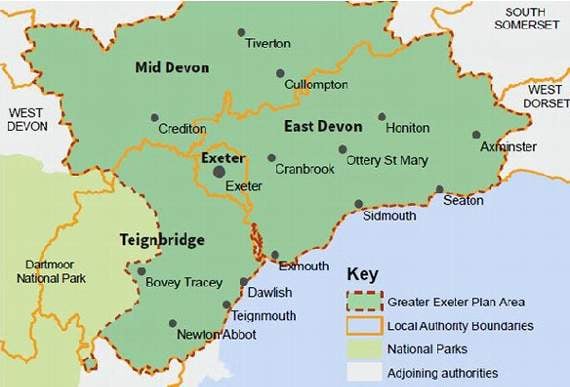PLANS to build thousands of homes in the area are included in the Greater Exeter Strategic Plan (GESP), which includes draft planning policies and large scale development options across four council areas for the next 20 years, up to 2040.
Mid Devon, East Devon and Teignbridge Councils are all considering whether to begin the next round of consultation about the proposals and on Tuesday, July 8, Exeter City Council agreed to proceed with consultation.
The Greater Exeter Strategic Plan will tackle big planning issues affecting the Greater Exeter area, of which Mid Devon is part of.
The plan includes climate change, meeting the need for new homes, jobs and infrastructure, transport and wildlife protection.
The GESP will also identify possible development sites across the area, including large regeneration sites in Exeter.
The proposals include, to the south of Exeter, 1,200 homes at Sweetham, Newton St Cyres, 750 at Crediton and 500 at Cowley, to name but a few.
NEWTON ST CYRES
The site at Newton St Cyres is around 8km from Exeter and comprises predominantly gently undulating agricultural land. The hamlet of Sweetham is located in the centre of the site with the larger village of Newton St Cyres on the south-west boundary. The site includes farms and isolated dwellings, with a golf course near Higher Rewe.
A total of 1,200 homes and employment land could be accommodated in the 303 hectare site, says the plan.
PROS
The site is reasonably close to Exeter, with the potential to access high quality jobs in the city, and the railway station offers the potential for residents to travel by train, with less than 10 minute journey time, into Exeter (or beyond), and residents could cycle to Exeter or Crediton. The characteristics of the site provides the opportunity to deliver a new sensitively designed rural settlement based on garden village principles.
CONS
A large area of the site is affected by flooding along the River Creedy and includes sections of Langford Road and Station Road. The highway network in the area is restricted and is likely to require significant investment to provide increased capacity and flood resilient access to the site, and the site is segregated by the Tarka Line railway, with access points to Sweetham over railway bridges on Langford Road and Station Road.
COWLEY
The area consists of 27 hectares of predominantly agricultural land surrounding and to the west of the hamlet of Cowley. Up to 500 homes could be built in the parish that comes under East Devon District Council.
PROS
It is close to significant job opportunities in Exeter city centre and the University, it has the potential to accommodate a Park and Ride/Change, and it could potentially deliver part of the Boniface Trail cycle route.
CONS
It may impact upon the Exe Estuary which is a Natura 2000 protected wildlife site sensitive to an increase in the number of visitors, while a small area of the site is affected by flooding. St. Andrew’s Road and the existing junction with the A377 would be an unsuitable access, Cowley Bridge and roundabout junction with Stoke Road/Wreford’s Drive are at capacity, and there are no schools within safe walking distance of the site.
CREDITON SOUTH
The plan says this 90 hectare agricultural site adjoins the southern boundary of the historic market town of Crediton, and could accommodate up to 750 homes.
PROS
There is a possible relationship with the sites at Newton St Cyres and Cowley to collectively deliver transport infrastructure, including rail, bus and cycle improvements. It is within walking distance of the services and facilities within Crediton, and the nearby railway station offers the potential for residents to travel by train, with a 10 minute journey time, into Exeter (with also the potential to travel north). The potential Cowley site option also considers provision of a Park and Ride, which would be an alternative means of accessing Exeter.
CONS
A large proportion of the site is identified as a monument of local importance – “Manor of Crediton Parks” (an undesignated medieval deer park), and the site may contain bats, otters and other protected species. A large proportion of the site is high grade agricultural land and a package of improvements to upgrade highway access and level crossing upgrade would be needed.
SECOND CRANBROOK
A “second Cranbrook”, relocating Exeter and Cullompton’s motorway service stations, and a regional sports hub are among the other proposals for major development in the Greater Exeter Area.
Further development around the edge of Newton Abbot, Honiton, Feniton, Axminster, Tiverton, Cullompton, and the area around Exeter are also proposed in the Greater Exeter Strategic Plan, for which a draft policies and site options document has been produced.
A minimum target of 2,663 homes per year, or 53,260 homes during the 20-year period of the plan, is required to be built, with the overall need for development sites equating to 63,912 homes.
Existing planning commitments – either unbuilt homes with planning permission or sites in local plans – amount to about 33,390 homes, with the GESP proposing that about 18,500 of the homes are provided on strategic scale GESP allocations, with 12,000 to be allocated on smaller sites via local plan reviews and also potentially in neighbourhood development plans.
The document takes forward a scenario of allocating the majority of the 18,500 new homes in the region near to public transport infrastructure corridors and hubs to maximise opportunities to encourage more sustainable forms of travel by giving the highest proportion of residents a choice of transport mode to the key service and job locations.
A total of 39 strategic site options are considered to have potential for allocation in the GESP, although following consultation to inform the final version of the GESP, not all sites will be taken forward for development.
Among the proposals in the GESP include relocating the J30 motorway services in Exeter and the J28 Cullompton services to a “super service station” near Poltimore in order to unlock the land at both sites for development.
Other proposals could see a large area of 660 hectares of rolling farmland extending from the A30 to the A3052 across Clyst Honiton, Sowton, Farringdon and Aylesbeare could be concreted over to see 10,000 homes built, with a further 1,300 homes allocated around Greendale, with a new link road to connect the A30 and the A3052 provided.
The Hill Barton site could also house a regional sports hub, with the Culm Garden Village expansion also having the same possibility.
Newton Abbot could see further expansion of the Houghton Barton site to the west of the town with an additional 1,750 homes, while a further 500 homes could be built on land to the south of the NA3 allocation.
More than 1,000 homes could be built to the East of Honiton, with 540 homes in Axminster, 2,800 homes around Feniton, and 2,500 homes around Whimple also sites to be consulted on.
To the south of Exeter, 1,100 homes around Shillingford and 1,500 homes at Peamore could be built.
Redevelopment of land around Marsh Barton, Exeter St David’s Railway Station, Topsham, Sowton, Pinhoe, and within the city centre allocate around 12,000 new homes within the boundary of Exeter
New railway stations at Marsh Barton, Monkerton, Cullompton, and Cranbrook East are proposed, as would 15-minute bus frequency on the routes on the A3052 to M5 J30, Heavitree Road, the A379 South West Exeter and around. Exe Bridges / Alphington Road.
PARK AND RIDE
Park-and-ride sites will be allocated around Exeter, with one on the Pinhoe Road B3181, Heavitree Road, Clyst St Mary, A379 Matford, A377/A30 Alphington Road and A377 Cowley Bridge corridors planned.
Land will be safeguarded for improvements around the Strategic Highway areas of junctions J27 and J28 of the M5, enhancements of local routes to improved capacity and resilience between M5 J29 to M5 J31, and the relocation of M5 J30 and J28 motorway services to one new “on-line” site.
A30/A303 improvements between Honiton and Marsh are called for, while a new link road between the A30 at Clyst Honiton and the A3052 could be built to allow movement without the need to use the motorway junctions.
CYCLE NETWORK
A comprehensive pedestrian and cycle network within Exeter is also proposed, with City Centre streets, including South Street, Fore Street, Paris Street, Queen Street, Heavitree Road and Cowick Street to have more priority given to active travel over the car.
A comprehensive pedestrian and cycle network within identified towns, including in Newton Abbot, Cranbrook, Crediton, Cullompton, Dawlish, Exmouth, Honiton, Teignmouth, Tiverton and the GESP allocations, will come forward at a later date.
Each council will be holding meetings to ask councillors to agree to the “draft policies and site options’” document and that a public consultation should begin in September.
Teignbridge’s Executive will consider the proposals and decide on July 21 followed by East Devon on July 23 and Mid Devon on August 6.
CONSULTATION
Councillors will be asked to approve the document for consultation and will not at this stage be making any decisions over which sites are taken forward for development within the final GESP document.
The consultation will ask for the public to have their say on the draft policies and site options, which will influence the next stage.
Councillor Graeme Barnell, Mid Devon Cabinet Member for Planning and Economic Regeneration said: “The Greater Exeter Strategic Plan draft policies and site options are due to be considered at a meeting of Mid Devon District Council’s Cabinet on August 6.
“If accepted for consultation by all four Councils that have been undertaking the joint planning work, the public consultation due to commence in September will be an important opportunity to feed views into the emerging plan."
Further information about the Greater Exeter Strategic Plan is available on the GESP website: https://www.gesp.org.uk .
• What do you think of the proposals? Why not share your views with fellow Courier readers.
Email a letter, suitable for consideration for publication, with your name and address (not necessarily for publication), to: [email protected] .by Alan Quick and Daniel Clark, Local Democracy Reporting Service





Comments
This article has no comments yet. Be the first to leave a comment.